Audi’s R8, while not a benchmark, was a shot across the bow of a lot of other supercar makers. It offered a lot of tech, style, and performance for, relatively speaking here, not much cash. Now there’s a new R8 out there, and Audi has just shown off the drop-top Spyder variant.
I liked the original R8s. Although they did have their faults – rather heavy, bad on the top end, a tendency to understeer at the limit – they also had a lot of assets – tons of grip, fantastic acceleration, marvelous on the road presence.
The new car, whether coupe or drop top, seems to lose a bit of that on the road presence, and now looks much more like a generic supercar. Gone are the distinctive and unique side-blades – those finishing panels just aft of the doors made of either bare carbon fiber or sexy brushed aluminum – replaced with a side-blade-esque scoop.
Sigh … too bad you let go of your signature move, Audi.
The new grill is a tragedy. Lacking in proportion, and completely devoid of subtlety, the nose is a step backwards.
But other than that, it’s still an impressive car.
Tradition & Tactics
The Spyder (that is with a “y,” in the German tradition of naming convertibles) is essentially the same as the new R8 V10 Coupe, minus the roof. 540 horsepower and 398 lb-ft. of torque motivate the beast with great alacrity, making the new R8 Spyder faster and more powerful than its predecessor.
There’s the same lump sitting amidships as before (no, the engine, not you). This would be the naturally-aspirated 5.2-liter V10 and seven-speed S-tronic dual-clutch transmission as the R8 V10 Coupe. This would also be the same V10 plant found in (cough-cough) various and sundry Lamborghinis. Audi doesn’t like to play up the fact, but dropping the Lambo V10 into an R8 really makes the thing sing. An Italian dressed in a Hugo Boss suit, if you follow me. So Audi’s acquisition of Lamborghini flowed good things in both directions.
Lambo got better-than-abysmal quality, and Audi got a real honey of an engine.
From The Top Down
The collapsible roof is made of lightweight cloth, keeping up with the growing trend of cloth replacing folding hardtops. I have a bit of a fetish for both convertibles and hardtops, so this trend strikes me as a bit retrograde, but my fetish has more to do with British cars and Pacific Northwest weather than any modern functionality. The current gen of folding soft tops seem to be fantastic.
If the day turns sunny, dropping the top is amazingly laid-back with this thing. Actuated by an electrohydraulic drive system, up to down or down to up takes you only 20 seconds. And, this is so cool, you can do it while on the roll, at speeds up to 31 mph. The roof itself weighs only 97 pounds, helping to keep the weight of the vehicle and center of gravity low (the main reasons for no folding hardtop). When you retract the top, it folds into a flat storage compartment over the engine.
Beyond the soft top, the 2017 Audi R8 Spyder is pretty much just like the coupe: light, tight, and handles right.
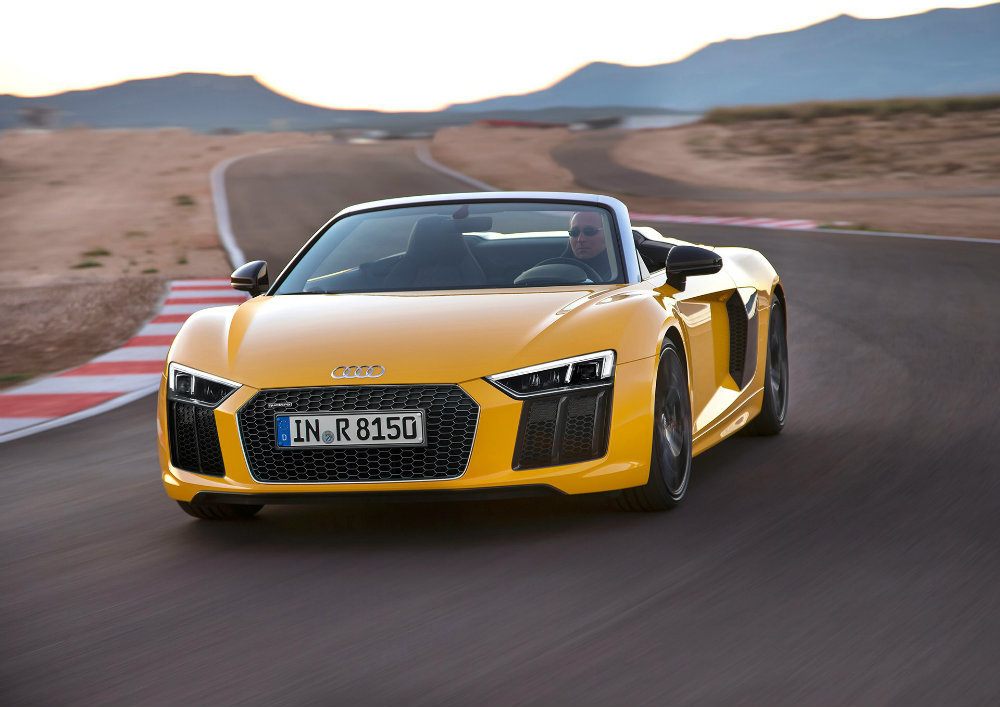
One of the car’s signature design elements is seen in the singleframe grille. It has a three dimensional honeycomb design and Anthracite Gray finish. Photo: Audi of America, Inc.
Sturdy Footing
Audi describes the new Spyder as having a “strong backbone” with its newly developed ASF aluminum and carbon fiber construction. Which is a jazzy way of saying this thing has the torsional rigidity of a steel I-beam and the weight of a bird bone. Like the previous R8s, the interior is all race car slick and driver focused; easy-to-operate controls and functions, including the fully digital Audi virtual cockpit that does away with traditional, mechanical gauges.
There’s no use to beating around the paddock about this: Audi makes no bones about the cross-pollination between the track and the street when it comes to the latest R8. Not only is there lots of racecourse derived stuff in the street version, the street version also forms the basis of the new R8 LMS GT3 racecar. Which Audi intends to mercilessly club its competition at places like Daytona and Le Mans and such.
Audi says the new R8 exemplifies an all-new application of the ASF lightweight chassis construction methods and uses a high percentage of carbon fiber materials. Aluminum components make up 80 percent of the chassis. Basically it’s shaped in a lattice structure that engineers then incorporate specific reinforcements into; the sills, A-posts, and windshield frame for example. This all adds up to the new Spyder being more than 50 percent stiffer than its predecessor.
All that rigidity is put to good use, thanks to the aforesaid 5.2-liter V10 engine and seven-speed S-tronic dual-clutch transmission. Yup, 540 horsepower and 398 lb-ft. of torque. Not shabby, but this car is also going up against things like the Ferrari 488 and Porsche GTS, so that’s actually a little on the low side. The V10 does rev like the business though, all the way up to an 8,700 rpm redline. This moves the R8 V10 Spyder from 0-60 mph in 3.5 seconds, one tenth faster than the previous generation.
Suspension & Drive Systems
The S tronic dual-clutch transmission is fully integrated with the Audi drive select system. And there is a new launch control program that delivers “a heightened level of acceleration through precise engine speed and an automated clutch release,” according to Audi.
There is a double-wishbone design for both the front and rear suspension and the weight is kept low with forged aluminum control arms. If you’d like, you could tick the option box for the dynamic steering, which gives you a variable steering ratio based on vehicle speed and the Audi drive select adjustment. The less direct steering ratio facilitates more stability the faster you go, and at lower speeds, you get increased steering response and easier maneuvering.
The new R8 Spyder rides on an updated version of Audi’s groundbreaking quattro all-wheel drive system. The majority of torque is transmitted to the rear wheels, but under certain driving conditions, the Spyder has the ability to send up to 100 percent of all available torque to the front axle. You know, conditions like heavy rain and such. The front axle has a new electronically controlled hydraulic multi-plate clutch; torque vectoring, and full quattro integration within the Audi drive select system are also utilized.
There’s a whole slew of tech goodies: Wi-Fi hotspot, LED lights all around, heated 18-way power sport seats, standard Bang & Olufsen Sound System with enough speakers and wattage to make you feel like you’re driving a Grateful Dead concert, but …
Now we come to the bad news: $ 175,100, MSRP.
That is the starting price for all this droptop, high tech, go fast goodness. So you’re nearly over 200-large by the time you’re out the door. But you know, if you’re a prospective 2017 Audi R8 Spyder owner, you’re probably not concerned much about stuff like cost.
Tony Borroz has spent his entire life racing antique and sports cars. He means well, even if he has a bias towards lighter, agile cars rather than big engine muscle cars or family sedans.
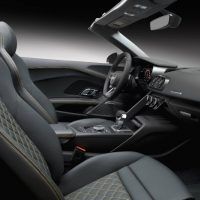
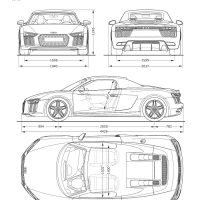
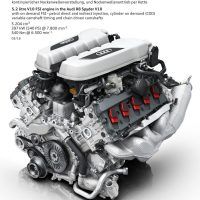
Photos & Source: Audi of America, Inc.
from Automoblog.net http://www.automoblog.net/2017/01/28/2017-audi-r8-v10-spyder-tony-stark-new-car-ready/
via IFTTT
from Tumblr http://peternpalmer.tumblr.com/post/156485754856
via IFTTT
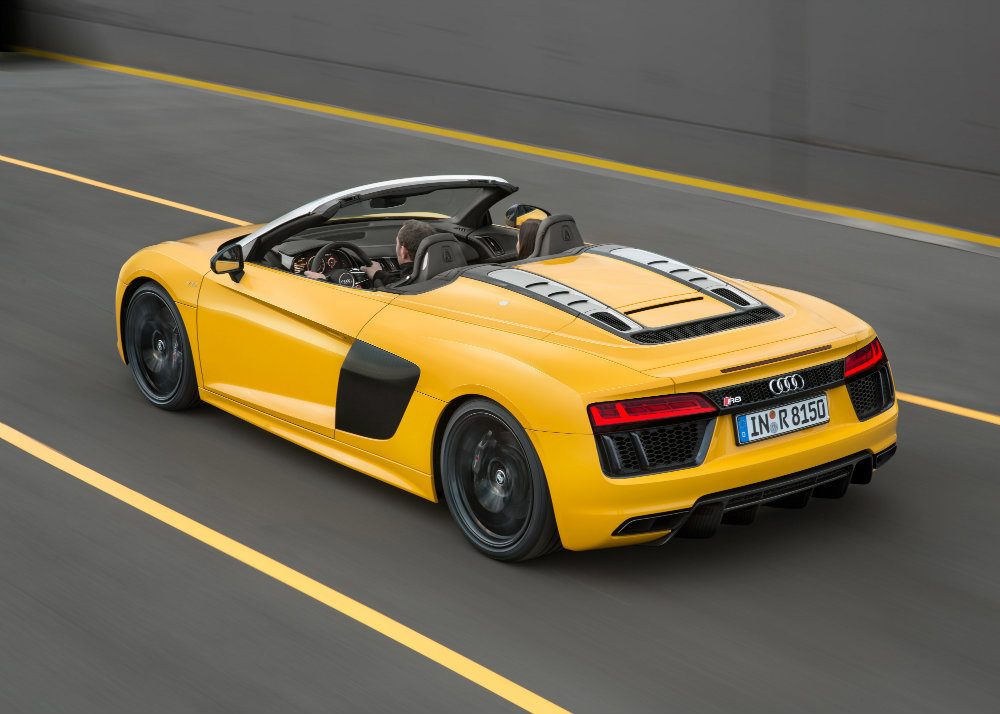
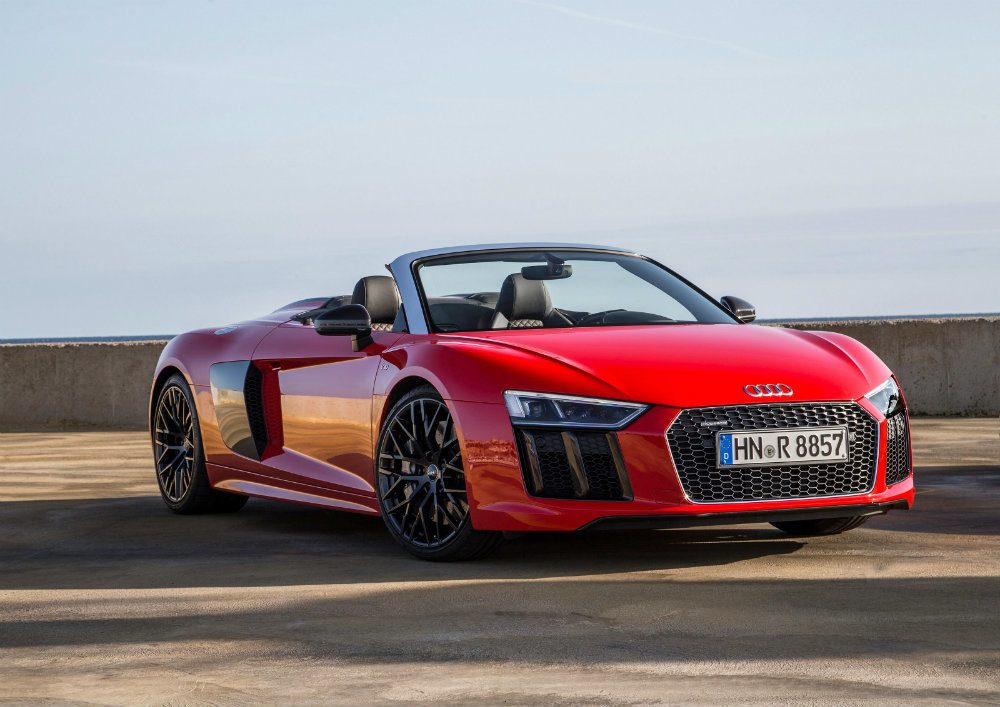
No comments:
Post a Comment